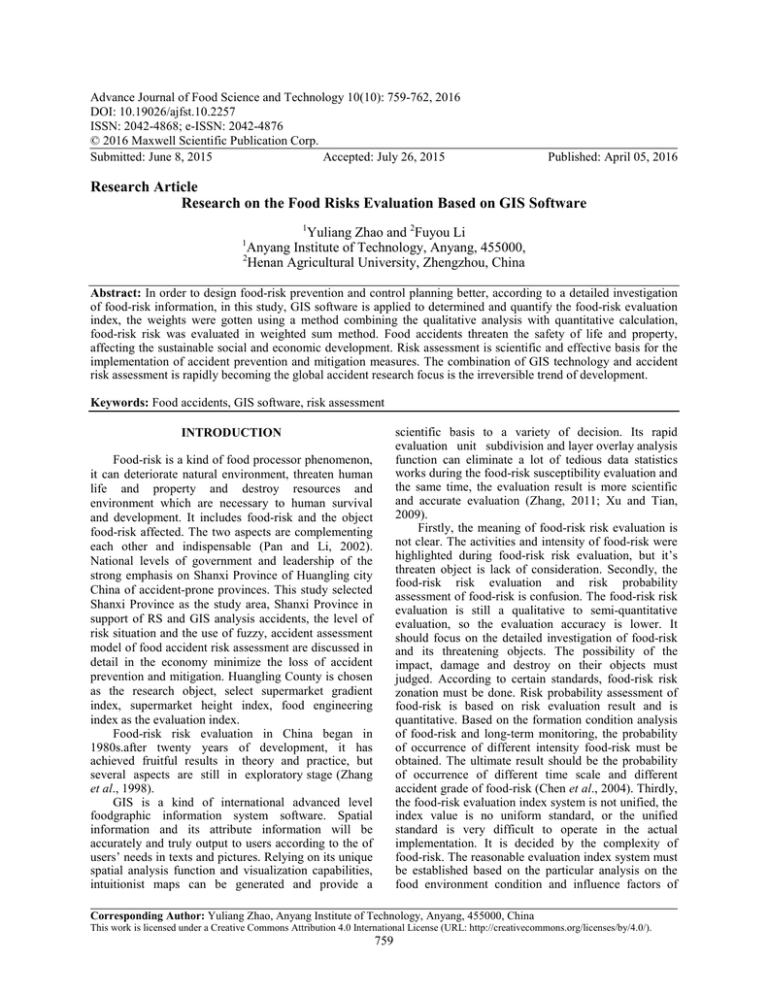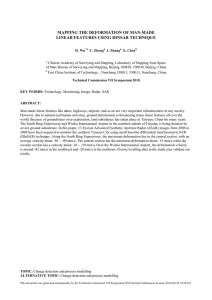Advance Journal of Food Science and Technology 10(10): 759-762, 2016
advertisement

Advance Journal of Food Science and Technology 10(10): 759-762, 2016 DOI: 10.19026/ajfst.10.2257 ISSN: 2042-4868; e-ISSN: 2042-4876 © 2016 Maxwell Scientific Publication Corp. Submitted: June 8, 2015 Accepted: July 26, 2015 Published: April 05, 2016 Research Article Research on the Food Risks Evaluation Based on GIS Software 1 Yuliang Zhao and 2Fuyou Li Anyang Institute of Technology, Anyang, 455000, 2 Henan Agricultural University, Zhengzhou, China 1 Abstract: In order to design food-risk prevention and control planning better, according to a detailed investigation of food-risk information, in this study, GIS software is applied to determined and quantify the food-risk evaluation index, the weights were gotten using a method combining the qualitative analysis with quantitative calculation, food-risk risk was evaluated in weighted sum method. Food accidents threaten the safety of life and property, affecting the sustainable social and economic development. Risk assessment is scientific and effective basis for the implementation of accident prevention and mitigation measures. The combination of GIS technology and accident risk assessment is rapidly becoming the global accident research focus is the irreversible trend of development. Keywords: Food accidents, GIS software, risk assessment scientific basis to a variety of decision. Its rapid evaluation unit subdivision and layer overlay analysis function can eliminate a lot of tedious data statistics works during the food-risk susceptibility evaluation and the same time, the evaluation result is more scientific and accurate evaluation (Zhang, 2011; Xu and Tian, 2009). Firstly, the meaning of food-risk risk evaluation is not clear. The activities and intensity of food-risk were highlighted during food-risk risk evaluation, but it’s threaten object is lack of consideration. Secondly, the food-risk risk evaluation and risk probability assessment of food-risk is confusion. The food-risk risk evaluation is still a qualitative to semi-quantitative evaluation, so the evaluation accuracy is lower. It should focus on the detailed investigation of food-risk and its threatening objects. The possibility of the impact, damage and destroy on their objects must judged. According to certain standards, food-risk risk zonation must be done. Risk probability assessment of food-risk is based on risk evaluation result and is quantitative. Based on the formation condition analysis of food-risk and long-term monitoring, the probability of occurrence of different intensity food-risk must be obtained. The ultimate result should be the probability of occurrence of different time scale and different accident grade of food-risk (Chen et al., 2004). Thirdly, the food-risk evaluation index system is not unified, the index value is no uniform standard, or the unified standard is very difficult to operate in the actual implementation. It is decided by the complexity of food-risk. The reasonable evaluation index system must be established based on the particular analysis on the food environment condition and influence factors of INTRODUCTION Food-risk is a kind of food processor phenomenon, it can deteriorate natural environment, threaten human life and property and destroy resources and environment which are necessary to human survival and development. It includes food-risk and the object food-risk affected. The two aspects are complementing each other and indispensable (Pan and Li, 2002). National levels of government and leadership of the strong emphasis on Shanxi Province of Huangling city China of accident-prone provinces. This study selected Shanxi Province as the study area, Shanxi Province in support of RS and GIS analysis accidents, the level of risk situation and the use of fuzzy, accident assessment model of food accident risk assessment are discussed in detail in the economy minimize the loss of accident prevention and mitigation. Huangling County is chosen as the research object, select supermarket gradient index, supermarket height index, food engineering index as the evaluation index. Food-risk risk evaluation in China began in 1980s.after twenty years of development, it has achieved fruitful results in theory and practice, but several aspects are still in exploratory stage (Zhang et al., 1998). GIS is a kind of international advanced level foodgraphic information system software. Spatial information and its attribute information will be accurately and truly output to users according to the of users’ needs in texts and pictures. Relying on its unique spatial analysis function and visualization capabilities, intuitionist maps can be generated and provide a Corresponding Author: Yuliang Zhao, Anyang Institute of Technology, Anyang, 455000, China This work is licensed under a Creative Commons Attribution 4.0 International License (URL: http://creativecommons.org/licenses/by/4.0/). 759 Adv. J. Food Sci. Technol., 10(10): 759-762, 2016 food-risk (Zhu et al., 2002; Liu and Tang, 1995; Zhang, 2002). • MATERIALS AND METHODS Information content analysis model: The information content can be gotten in the model as the quantitative indicators for food-risk risk evaluation by calculating the amount of information of various influence factors on the food-risk deformation and failure. It can accurately reflect the basic law of food-risk, but also it is simple, easy, practical, easy to promote. The calculation principle and the process are showed as follows: • Because the basic data of evaluation indictor mainly come from quantitative description, so, they must be dimensionless unified in standardization, normalization, homogenization, or logarithmic, square root and other numerical transformation method, before substitute in evaluation model. Food-risk features: According to the food-risk survey data in Huangling County, Shaanxi Province, the foodrisk evaluation index system is established. The assignment principles of evaluation factors are proposed. The food-risk evaluation is done and divided in all area. During food-risk detailed survey, 350 survey point is investigated.115 food transportation are found, accounting for 32.85% of the total number of food-risk points, accounting for 32.85% of the total number of food-risk points. Thirty two food quality are investigated, counting for 9.14%.5 beverage flow are investigated, accounting for 1.42%. 180 unstable supermarket are investigated, accounting for 51.42%.11 food grade are investigated, accounting for 3.14%; 7 fruit fissure are investigated, accounting for 2.03% (Table 1). Calculating the information content I(xi/A) of food-risk instability (A) provided by single factors (indicators) xi: I ( xi , A) = lg P( xi / A) P( xi ) (1) where, P(xi/A) indicates the emergence probability of xi on the food-risk deformation and failure conditions; P(xi) indicates the emergence probability of xi in overall condition: I ( xi , A) = lg Ni / N Si / S (2) where, S = The total number of known sample units N = The number of known deformation and failure sample units Si = The number of units xi appear Ni = The number of deformation and failure units xi appear • p i =1 • RESULTS AND DISCUSSION Evaluation unit: The division of evaluation unit is variety and each has advantages and disadvantages. The division form and the size of unit have great impact on the evaluation result. On the basis of the DEM data, all study area is divided into 6258 units using hydrological analysis method by GIS software. Calculating the information content Ii of the foodrisk deformation and failure on some unit provided by combinations with P kinds of factors, namely: I i = I ( xi , A) = ∑ lg Ni / N Si / S regional. The value of the information in some unit is greater, the food-risk is more easily to deformation and damage. Identifying mutations point as the cut-off point, by statistical analysis (subjective judgments or cluster analysis), so as to the area is divided into different levels. Evaluation weights: The evaluation index weights directly affect the accuracy and effectiveness of the food-risk evaluation results. Therefore, the weight is the key of the food-risk risk evaluation and is difficult to gotten. In the existing evaluation model, the main methods commonly used in AHP, gray correlation method, neural networks, etc., these weight calculate methods are summed up in two types: subjective and objective analysis method. Subjective analysis method is through expert subjective analysis in order to achieve qualitative to quantitative conversion. However, this approach is subjective too much and do not combine with the evaluation results. On the contrary, objective analysis is through the objective information extraction and analysis on statistical data of the factor, finding out the rules to determine the weights. The method is overreliance on objective data, while ignoring the experts; the calculated results are often unsatisfactory. (3) Determining the stability level of the unit according to the size of Ii: Ii <0 indicates that the possibility of deformation and failure of the unit is less than the average possibility of deformation and failure in all regional; Ii = 0 indicates that the possibility of deformation and failure of the unit is equal to the average possibility of deformation and failure in all regional; Ii> 0 indicates that the possibility of deformation and failure of the unit is more likely the average possibility of deformation and failure in all 760 Adv. J. Food Sci. Technol., 10(10): 759-762, 2016 Table 1: Food-risk statistics The number of food-risks ------------------------------------------------------------------------------------------------------------------------------------------------------Food Unstable Total transportation Food quality Beverage flow supermarket Fruit fissure Food grade Town name Qiaoshan 61 18 8 0 35 0 0 Diantou 50 12 7 1 25 2 3 Shuanglong 47 6 6 1 32 0 2 Cangcun 37 14 1 0 9 7 6 Longfang 33 11 5 0 17 0 0 Tianzhuang 30 13 2 2 13 0 0 Hexi 25 6 1 0 15 3 0 Yaoping 25 6 0 1 18 0 0 Taixian 19 12 1 0 4 2 0 Adang 18 10 0 0 8 0 0 Houzhuang 13 7 1 0 3 2 0 Fig. 1: Division of food risk Therefore, the two methods are combined. Firstly depending on experts’ experience, a set of weights are given and then selected a number of typical evaluation unit, we can get the qualitative evaluation results through the food-risk characteristics and their environmental conditions, then using the evaluation factors and weights given on experts’ experience, the food-risk risk of the typical evaluation unit selected can be quantitative evaluated, the weights gradually modified until the evaluation results are consistent with qualitative analysis results. The final weights can be used as the weight of the whole region. Food-risk risk zoning map and the actual survey result are overlaid as shown in Fig. 1. It can be seen that the quantitative analysis results are consistent with the actual results; the most of measured food-risk points are located in high-risk areas and mid-risk areas. Thus, the food-risk risk evaluation result in the paper is creditable. CONCLUSION The results show that the areas have great resident population, frequent movement of floating, fast urbanization and strong human engineering activities. The high-risk and middle-risk food-risks are widely developed. The risk evaluation result is consistent with the actual situation and is credible. After contrast the evaluation result with the actual investigation, it can be found that the evaluation result has good agreement with the actual investigation. 761 Adv. J. Food Sci. Technol., 10(10): 759-762, 2016 Zhang, Y.Q., 2002. Mathematical model of environmental risk prediction. J. Environ. Manage. Coll. China, 1: 26-29. Zhang, L., 2011. Application of MAPGIS software in food risk survey and zoning. Technol. Guide, 20: 350-361. Zhang, L., Y.C. Zhang and Y.H. Luo, 1998. Theory and Practice of food risk Assessment. Food Publishing House, China. Zhu, L.F., K.L. Yin and L. Zhang, 2002. Risk analysis system of food-risks supported by GIS. J. Yangtze River Sci. Res. Inst., 19(5): 42-45. REFERENCES Chen, Q., Z.Y. Li and H.L. Shi, 2004. Thoughts and basic methods of regional food risk risk assessment. J. Food Mech., 10(1): 71-80. Liu, X.L. and C. Tang, 1995. The Risk Evaluation of Food Flow. Science Press, China. Pan, M. and T.F. Li, 2002. Accident Foodlogy. Beijing University Press, China. Xu, M. and Y.S. Tian, 2009. Application of M APGIS system in the prediction of food accidents. J. Ningxia Teach. Univ. Nat. Sci., 3(6): 60-76. 762



